地址:北京市海淀區(qū)中關(guān)村北大街100號(北樓)北京大學(xué)建筑與景觀設(shè)計學(xué)院一層 Email:info@landscape.cn
Copyright ? 2013-2022 景觀中國(www.36byz.com)版權(quán)所有 京ICP備05068035號
 京公海網(wǎng)安備 110108000058號
京公海網(wǎng)安備 110108000058號
Landscaping Beyond Artistic Correctness丨Longfor · Jade Mansion, Xiamen
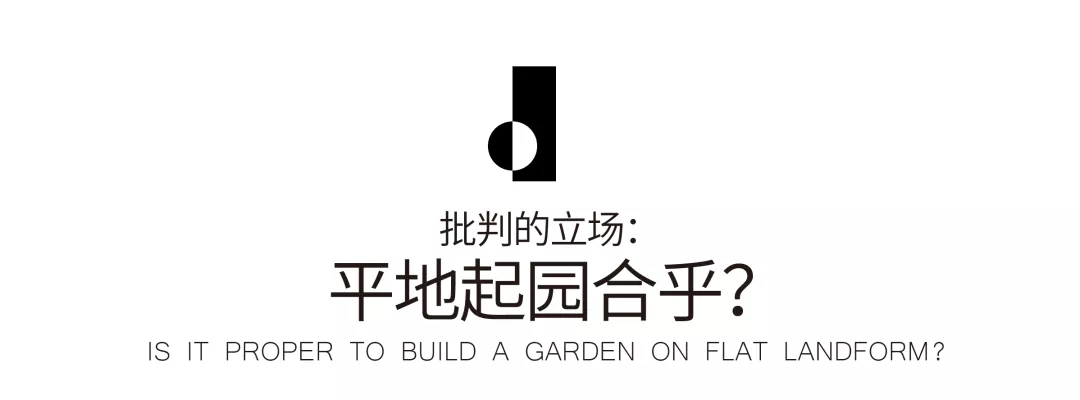
如何造園?時下風(fēng)景園林師的標(biāo)準(zhǔn)回答是:以場地為基,場所精神和文化特質(zhì)……而后,再言尺規(guī)圖畫。
場地精神,成為空間藝術(shù)的金線,無可逾越,是為藝術(shù)正確。但現(xiàn)實卻大多事與愿違:城市樓盤多數(shù)是推倒重來,或是一片新城的灰色基礎(chǔ)設(shè)施上“平地起高樓”……
因此,在具體的項目中,我們更需要坦然面對一處城市白板,有節(jié)制地、坦誠地尊重應(yīng)該珍視的存留。嘗試丟掉生拉硬扯的厚重與冠冕,撕扯掉沉重的包袱,去無中生有地營造佳境。
形式、空間、精神、敘事、生活、功能等等,都是造園的切入口和途徑,不存在絕對正確的路徑,沒有永恒的有效性,更沒有對與錯的價值標(biāo)準(zhǔn)。而特定坐標(biāo)中的生成過程本身是否符合邏輯和常識,大概是唯一的優(yōu)劣評判。
How to create landscape? The standard answer from contemporary landscape architects is that landscape design should be based on the site and take into account of the spirit of the place and the local culture ...... and then you can think about concepts and drawings.
The spirit of place has become an impassable golden line for space art which is known as the artistic correctness. In practice, however, such a standard is counterproductive, since most of the residential developments are completely built on old residential sites or wastelands of a new town ......
Therefore, in face of a project, we need to accustom ourselves to a “blank” site, respecting and keeping the precious existences and trying not to create landscapes mechanically.
Form, space, spirit, narrative, life, function, etc. all of them are starting points and approaches to landscaping. There is no absolutely correct approach, no eternal validity, and no right or wrong standards of value. The only way to judge a project may lie in whether the design process is reasonable and logical.

既然是平地起園,設(shè)計的起點、思維框架和演變需要一個強(qiáng)有力的“抓手”。能成為抓手的原型(prototype)千千萬萬,而在廈門首開龍湖·璟宸府項目中,設(shè)計師掠取的原型是山水文化的 “游”觀。
“游”這個理想的居行原型能夠滲透出三種重要的景觀概念:時空—身體運(yùn)動—精神棲居,這些帶有理論性能量的術(shù)語既是設(shè)計生成的思想框架,又是設(shè)計體驗層面上的歸宿。
To create landscapes from nothing, you need to find a “prototype” on which to base the design from beginning to developing. As for Longfor ·Jade Mansion, Xiamen, the designer takes “travel” from the landscape culture as the “prototype”.
As an ideal prototype for living and travelling, “travel” embodies three important landscape ideas: time and space, physical activity and spiritual dwelling, which are the basis and aim of design.
時空體
“游”其實是回歸到中國傳統(tǒng)的思想體系中找尋遺落的寶藏,這個寶藏是把景觀看成一種動態(tài)的、連續(xù)的時空體,而非靜止的、框定的視覺客體。
在中國山水畫中,觀者或畫中人就是“游”于二維的平面中。恰是“游”的姿態(tài),導(dǎo)致這種觀畫行為成為一種既內(nèi)化于時間又超越時間的體驗。同理,“游”于園林也會讓時間具化成棲居之態(tài),而想要獲得棲居的理想境界,我們首先要認(rèn)識到景觀(山水)是一種多維的時空綜合體。
Space-time Complex
"Travel" actually means returning to the traditional Chinese ideological system to find the lost treasure, which regards landscape as a dynamic and continuous space-time complex rather than a static and framed visual object.
In Chinese landscape paintings, the viewer or the person in the painting is just "travelling" on a two-dimensional surface. It is the gesture of “travel” that contributes to an experience beyond time. From this perspective, “travelling” among landscapes will allow visitors to experience the ideal lifestyle. And in order to create an ideal living environment, we should first realize that landscape is a complex of multiple dimensions.

身體運(yùn)動
“游”的另一個重要內(nèi)涵,即身體運(yùn)動(這里,身體運(yùn)動既有動觀,也包括靜觀)。實際上,景觀的時空綜合體可以理解成:在空間中不斷移動的身體,隨著時間性的持續(xù)展開,人物沉浸到一起的狀態(tài)。
當(dāng)然,我們可以用動覺(kinesthesias)這個時髦的理論來為之賦能。當(dāng)觀者的身體穿過景觀空間時,存在著一股源于外部環(huán)境的動態(tài)流動的知覺(perceptions),而且有肌肉和神經(jīng)上的活動。各種運(yùn)動(奔跑、踱步、跳舞或者漫步)都可以發(fā)生于景觀,身體移動的步幅和頻率甚至能改變著彼此之間的意義。
Physical Activities
Another meaning of "travel" is physical activities, including both movement and meditation. In fact, the space-time complex can be understood as people keeping moving in a space and immersed together with time going by.
Of course, we can use the fashionable theory of kinesthesias to empower the space. When visitors pass through the landscape space with muscular and neural movements, they can experience a dynamic flow of perceptions from the surroundings. All kinds of sports, such as running, strolling and dancing, allow people to interact with the landscape, and the pace and frequency of body movements even provide a new perspective on the landscape.
棲居精神
無論是時空體,還是身體運(yùn)動,說到底,于山水之間尋求詩意的生活狀態(tài),是古人安置流動生命之所。而在海德格爾的意義上所關(guān)心的問題是,如何讓筑造活動(Bauen)等同于詩意居住/棲居(Wohnen)。
從原型,到概念,到物質(zhì)時空體,再到身體體驗;從人,到景,到身體,再到精神狀態(tài),由“游“切入的景觀營造,就是要實現(xiàn)“擬入畫中行”的理想世界。
Spirit of Dwelling
The purpose of the space-time complex and the physical activities is to search for a poetic lifestyle among the landscapes. As for Martin Heidegger, the problem lies in how to make Bauen equal to Wohnen.
From prototype to concept, from space-time complex to body experience; from visitors to landscapes and then to the sate of body and mind, “travel” makes people part of the “l(fā)andscape painting” and creates an ideal world.


設(shè)計草圖是一個中間的銜接環(huán)節(jié),讓前期的概念原型與后期的物理空間營造實現(xiàn)有效過渡。因此,一遍遍推敲,一次次試錯,一回回修改,就是要通過設(shè)計活動,把“游”與“營造”緊密串聯(lián)起來。
The design sketches serve as the transition between conceptual prototype and space construction. Therefore, we’ve carefully proposed, tried and modified again and again, trying to connect “travel” closely with “l(fā)andscaping”.




聆聽空間的要求
設(shè)計的目的,不是孤芳自賞的輸出,也不在于單一景觀載體的設(shè)計,而是通過聆聽場地的內(nèi)在訴求,繼而創(chuàng)造一系列的元素,由此組成整體來定義并塑造空間。
Listening to the Space
The purpose of design is not for self-admiration or to simply build some landscape, but to create a series of elements that can define and shape the space based on the requirements of the site.


孤松、陋石與白巖,為了不讓過多的材質(zhì)打亂空間的質(zhì)感,我們謹(jǐn)慎而克制地選擇材料,借助質(zhì)感和大小的變化,去呈現(xiàn)出空間純粹自然的感覺。
Decorative elements such as the pine, rough stone and white rocks are carefully selected to avoid too much interference in the space. Materials of different texture and size are employed to present a pure natural space.


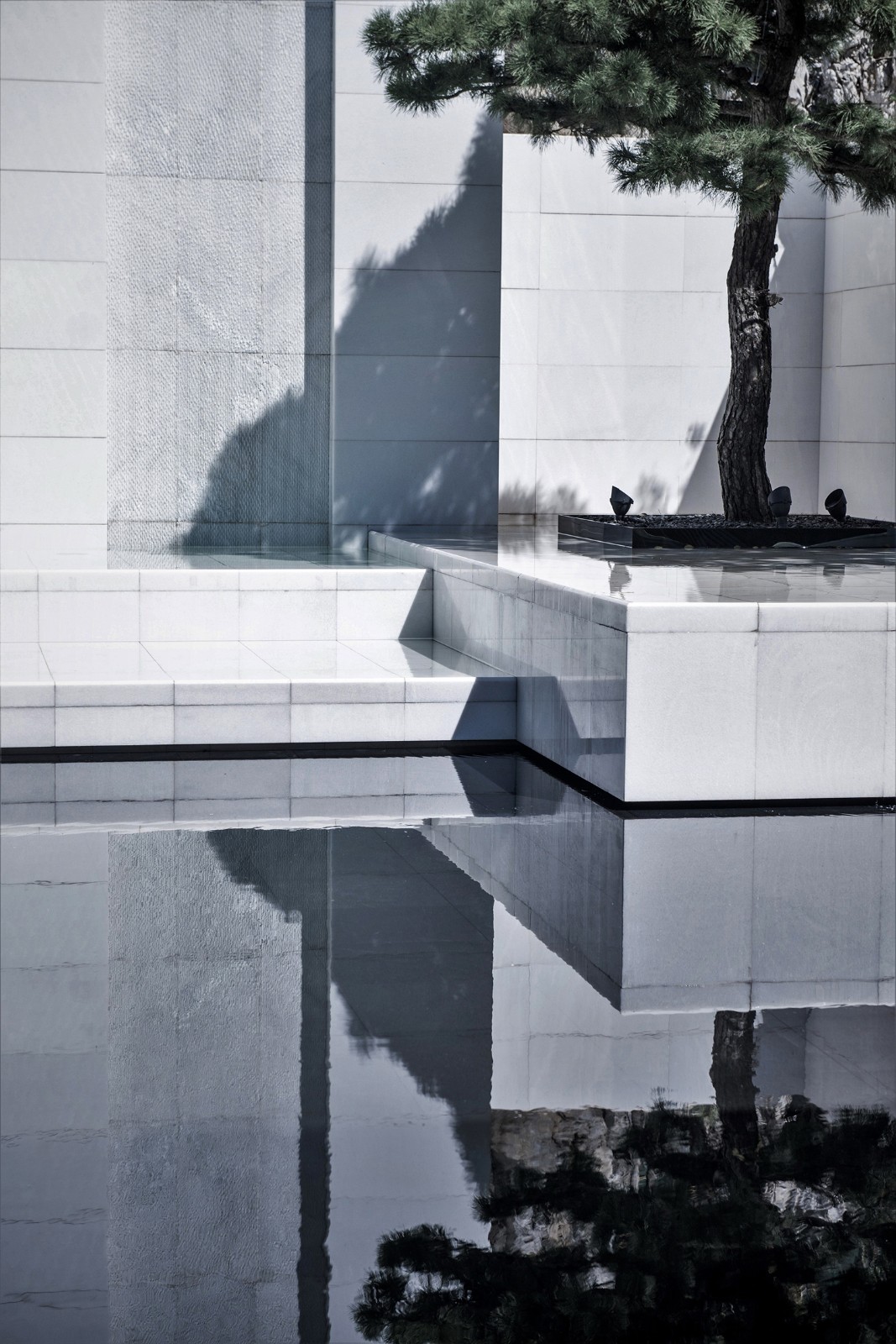

場域線索的生發(fā)組織
“美,不存在于物體之中,而存在于物與物產(chǎn)生的陰翳的波紋和明暗之中。” 空間的層次性,往往體現(xiàn)在對過渡空間的處理細(xì)節(jié)上,那些瑣碎、低微、細(xì)小的場域線索,逐一生發(fā)、組織。
Formation and Organization of Space Clues
"Beauty does not exist in object itself, but between the objects." Well-designed transitional spaces will help to shape the multiple levels, while the exquisite details will form the clues of the whole space.

太湖石的剪影似雕塑,一動不動。光線透過月洞門進(jìn)入廊道,萬籟寂靜。沒有明確形態(tài)的光線彌漫于場所之中,或靜坐或躺臥,人和場域也并置層疊了。
The sculptural stone stands still and the light pours through the moon gate into the corridor, allowing people to feel totally at ease in this quiet and peaceful space.

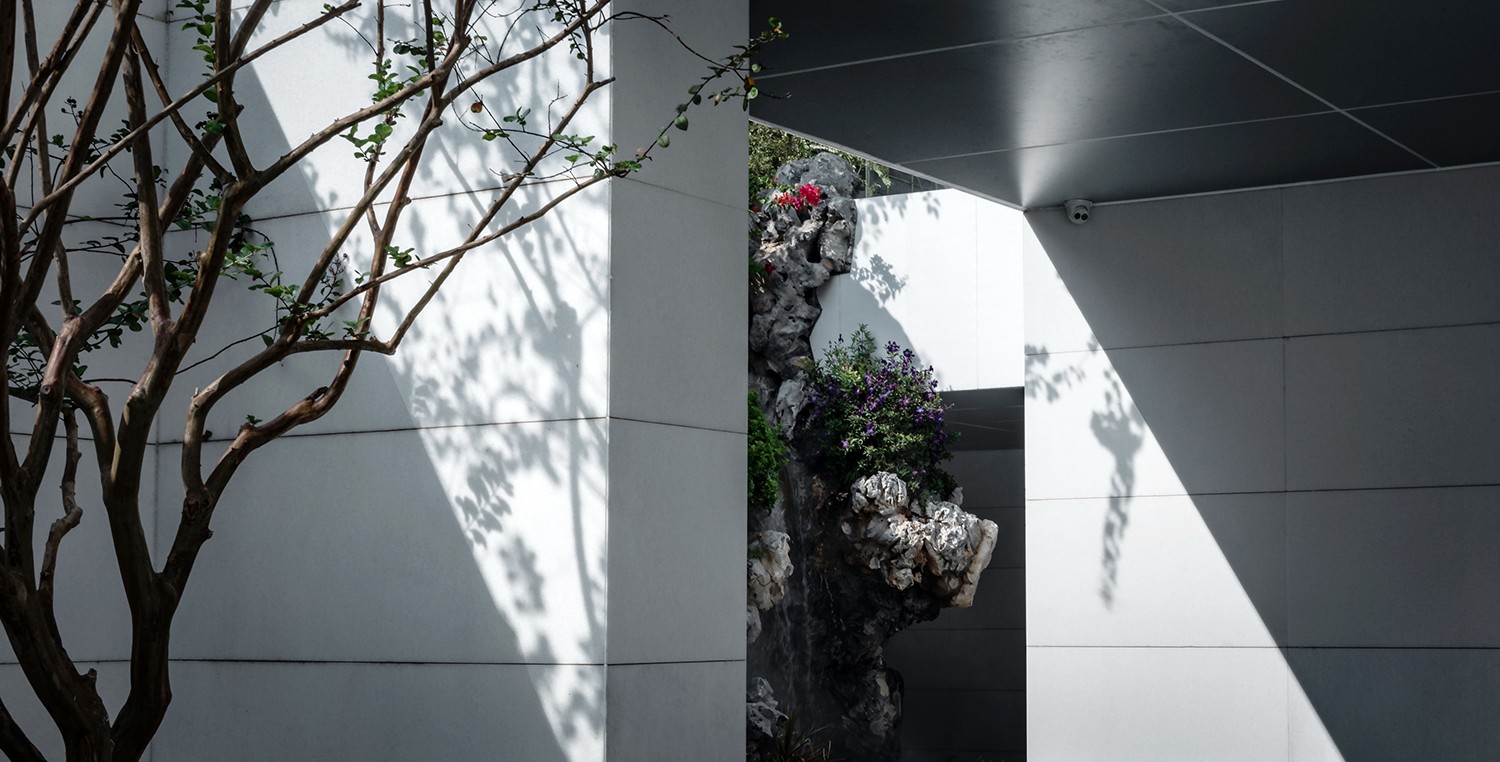
門與廊的介入、空間邊界的過渡,借鑒了古典園林對空間之間銜接與對空間邊界的處理手法,營造出富有層次的空間結(jié)構(gòu)。
Gate, corridor and transitional spaces are designed in the same way as the classical gardens, creating a space structure of multiple levels.
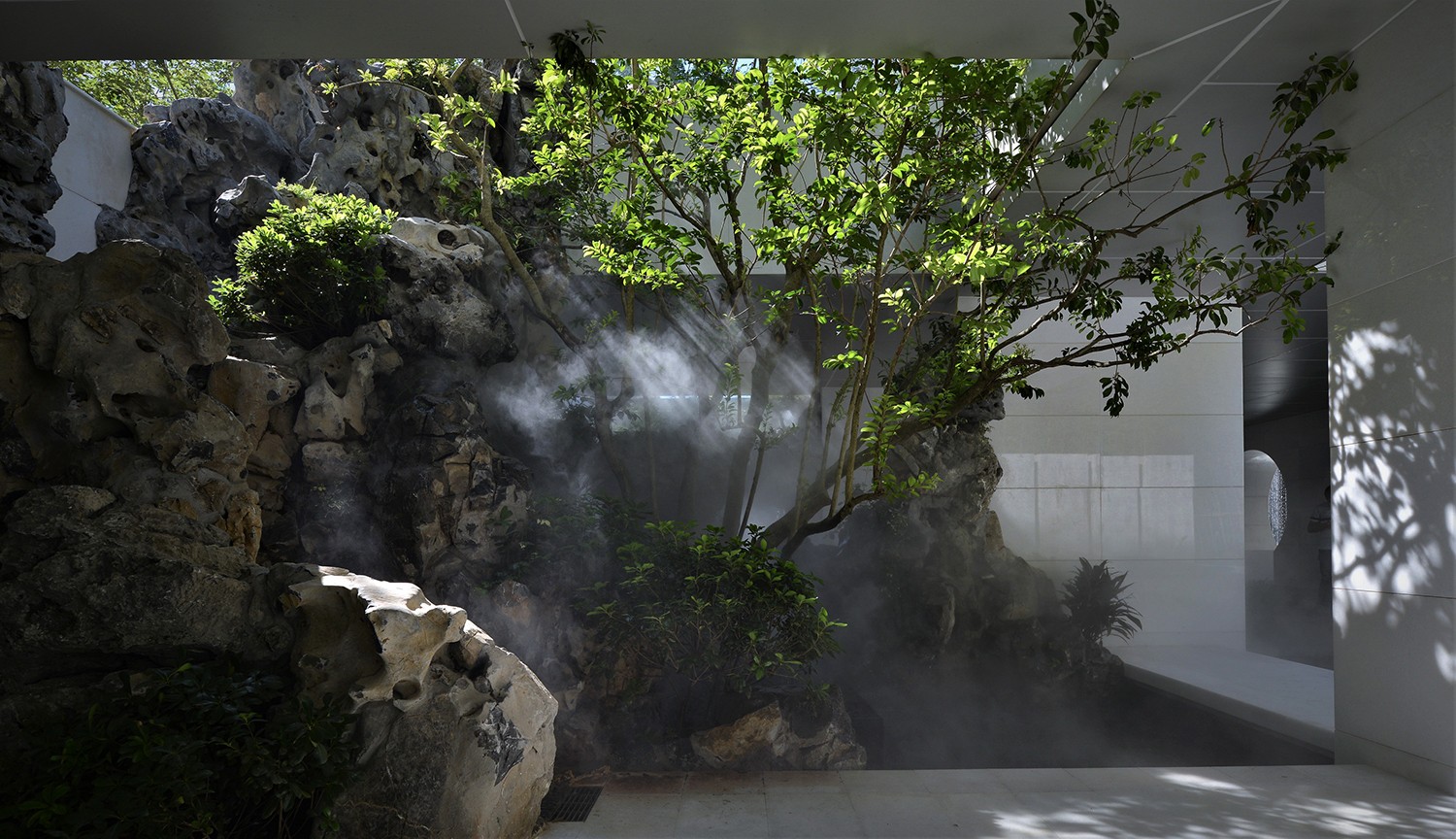



時空變化的可能性
我們試圖探索一種舍掉終極的、完整的、永恒不變的、可完全預(yù)判的景觀模式,轉(zhuǎn)而強(qiáng)調(diào)一種隨著時間推移不斷產(chǎn)生變化的、超出規(guī)劃設(shè)定的景觀類型。對于廈門首開龍湖·璟宸府的景觀結(jié)構(gòu)而言,不止空間,還包括時間,具有時間與空間相互疊合的復(fù)合特征。
Possibility of Space-time Changes
We try to give up an ultimate, complete, unchangeable and predictable landscape pattern, and turn to one that is changing as time goes by. The landscape design of Longfor · Jade Mansion not only focuses on space but also takes time into consideration, creating a dynamic landscape space that can change with time.


當(dāng)人們置身景觀時空中,感受四季流轉(zhuǎn)、時空變幻時,便有了流動性的景觀體驗。這個空間不光是戲劇性的,還是生活的。
When in the landscape space, one can experience different beauty with the changing seasons, since the space is not only for exhibition but also for life.

借鑒山水畫的創(chuàng)作理論,設(shè)計師有意營造一條立體游線,以重現(xiàn)人在山水環(huán)境中的體驗感。先是在光影游廊穿越;在游廊的盡頭仰望天際;步上登高平臺時,視線逐步抬升;最后到達(dá)登高平臺,實現(xiàn)無限眺望。
Based on the theory of landscape painting, the designer hopes to create a three-dimensional “travel route” which will lead people to pass through the corridor, step up the terrace and overlook the whole space from the top.




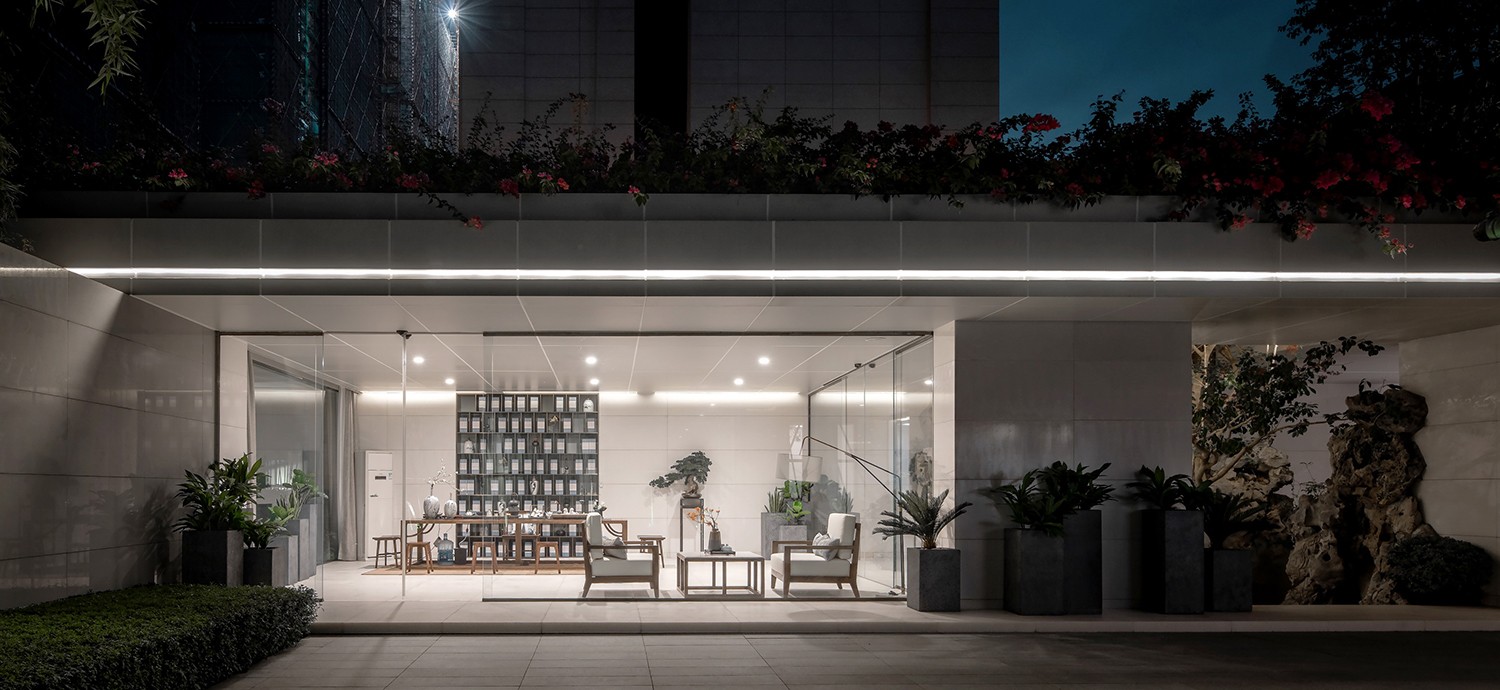
Ending
空間和電影一樣,構(gòu)造著解剖式的運(yùn)動圖像、生活空間和生活敘事的動態(tài)軌跡。
空間不再作為審美凝視的對象,而是支持人與人之間的風(fēng)景。空間不是關(guān)于單一主體與外在世界的,而是主體之間的,因而是關(guān)于情感、欲望、有意義的行動。空間本身無意義,因為其對人與他人之間關(guān)系的經(jīng)營而獲得意義。
Just like the film, the space is also created to record people’s life and movements and tell stories.
It is no longer an object for appreciation but the landscape that encourages the interaction between people. In the space, people will not only interact with the surrounding environment but also communicate with others. It is the function of promoting the relationship between people that makes the space meaningful.



|項目信息
項目名稱:廈門首開龍湖·璟宸府
委托業(yè)主:廈門瑩泰置業(yè)有限公司
景觀設(shè)計:廣州山水比德設(shè)計股份有限公司
園林施工:廈門唐宋景觀設(shè)計工程有限公司
建筑設(shè)計:匯張思建筑設(shè)計咨詢(上海)有限公司
項目地點:福建省廈門市
設(shè)計面積:54282.36㎡
設(shè)計時間:2017年7月
建成時間:2019年9月
| Project Information
Project: Longfor · Jade Mansion, Xiamen
Developer: Xiamen Yingtai Property Co.,Ltd.
Landscape Design: Guangzhou S.P.I Design Co.,Ltd.
Landscape Construction: Xiamen Tangsong Landscape Design & Engineering Co.,Ltd.
Architectural Design: HZS Architecture Design (Shanghai), Ltd.
Location: Xiamen, FuJian
Design Area: 54,282.36㎡
Time of Design: July, 2017
Time of Completion: September, 2019
 廣東廣州
廣東廣州
 www.gz-spi.com
www.gz-spi.com
